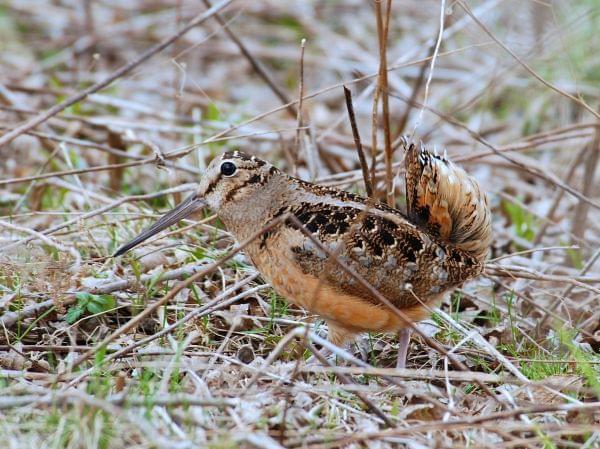Return of the American woodcock—another March madness

An American woodcock struts his stuff at Meadowbrook Park in Urbana. Greg Lambeth
One of the early season highlights of birding in central Illinois is the widespread return in March of a bird called the American woodcock. Indeed, for some birders this phenomenon holds just as much interest as that other one more commonly known as March madness.
The woodcock belongs to the shorebird family, whose more familiar members include sandpipers and plovers. But unlike its cousins, the woodcock prefers habitat composed of moist woods, open fields, and brushy swamps. You won’t see a woodcock poking along beaches or mud flats the way other shorebirds do. Most of the time the woodcock is so secretive and so well camouflaged that unless you witness its courtship display, you’re likely to see one only if you come close to stepping on in it, and it flushes. Then you are startled by an explosion of wings at your feet, after which you’ll have five to ten seconds to watch the bird fly before it lands and takes cover again.
On the ground, the woodcock’s appearance suggests that it was constructed by a birdmaker who didn’t pay strict attention to the shorebird blueprint. It’s a plump bird, about eleven inches long altogether, although its bill accounts for three of those inches. This bill is highly sensitive, which enables woodcocks detect the vibrations made by earthworms underground. And it features a flexible tip that can be opened to grasp worms even while the rest of the bill remains closed.
A woodcock’s eyes bulge out like black, stick-on doll-eyes that are attached in the wrong spot—just a little too high up, and too far back on its head. Odd as it may look, this arrangement allows the woodcock a super wide field of vision—nearly three hundred sixty degrees. This is quite a useful adaptation for a bird that spends so much time with its nose to the ground.
Appearances aside, what endears the woodcock to birders is the strange and elaborate courtship ritual that the males perform at dusk and dawn in the spring. Many people have written to describe this behavior, although none so eloquently as Aldo Leopold, whose book, A Sand County Almanac, has done so much to inspire the modern conservation movement.
This is how Leopold describes the male woodcock’s “sky dance”:
He flies in low from some neighboring thicket, alights on the bare moss, and at once begins the overture: a series of queer throaty peents spaced about two seconds apart, and sounding much like the summer call of the nighthawk.
Suddenly the peenting ceases and the bird flutters skyward in a series of wide spirals, emitting a musical twitter. Up and up he goes, the spirals steeper and smaller, the twittering louder and louder, until the performer is only a speck in the sky. Then, without warning, he tumbles like a crippled plane, giving voice in a soft liquid warble that a March bluebird might envy. At a few feet from the ground he levels off and returns to his peenting ground, usually to the exact spot where the performance began and there resumes peenting.
Depending on conditions, the male woodcock may repeat this performance for a half hour or more.
If you would like to see the sky dance for yourself but don’t know where to look, check out one of the upcoming “Woodcock Walks” conducted by the Champaign County Forest Preserve District.
See more bird photos by Greg Lambeth at http://greglambethbirdphotos.smugmug.com/

